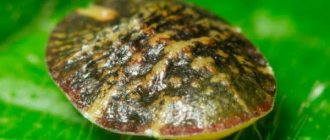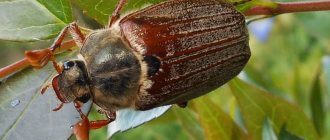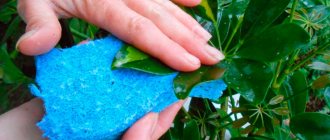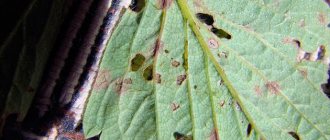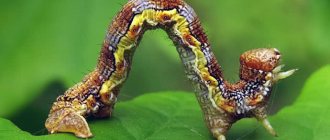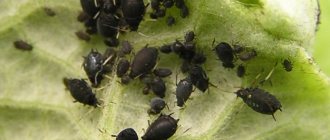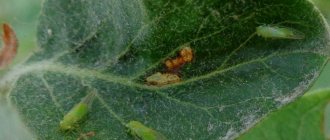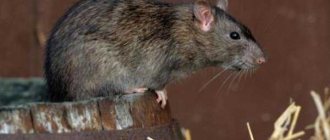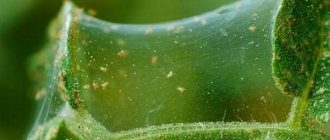3.7
(3)
Gardening is not about harvesting a long-awaited harvest. Or rather, this is the final part of the work that has to be put in every day throughout the year. Yes, yes, a gardener works all year round - in the fall he prepares trees and bushes for winter, in the winter he protects them from rodents and frost, in the spring he takes care of providing the plants with the substances necessary for growth, in the summer he removes weeds, and protects them from birds. But most of the time during the warm period we have to fight insect pests. In this article we will tell you why scale insects appear on apple trees and how to fight them using folk and chemical treatment methods.
What is scale insects and its types
The pest got its name due to the fact that it has a special shield for protection. It consists of the remains of larvae, which are securely glued together. Externally, the protective coating of scale insects resembles dark tree bark.
Among the characteristics of insects, their small size, about 4-5 mm in length, is distinguished. They feed on juice found in apple fruits and tree leaves. This is why many recommend getting rid of scale insects immediately. If this is not done in time, the ovaries, ripe apples and leaves will begin to darken and rot.
Signs that indicate the presence of insects include:
- cracking of the bark, which is accompanied by falling branches;
- yellowing and curling of leaves;
- slowing down the growth of trees, due to which they can dry out.
There are several varieties of scale insects that can appear on apple trees:
- Californian. It appears not only on apple trees, but also on many other fruit trees. When plants are infected, black dots with light spots appear on the leaves.
- Comma-shaped. Apple comma insects are easy to spot because they are white in color. They have an oblong shape and grow up to 3-4 cm. Such insects can easily tolerate temperatures dropping to 25-35 degrees below zero.
- False shield. The pest affects apple trees, gooseberries, currants, bird cherry, and raspberries. Individuals differ from other varieties by a flat shield of a yellowish tint.
We identify a pest by appearance: how to understand the species
To choose the right drug or folk remedy against the caterpillar, you need to know the enemy by sight. There are a huge number of species of butterflies that lay eggs, and each caterpillar of its own species has characteristic features. For ease of understanding, we will conditionally divide pests by color.
Black
There are few species of black caterpillars that attack apple trees. The most remarkable and noticeable is the gypsy moth caterpillar. This is a large, hairy caterpillar about 7 cm long. The body is black with red dots and yellow longitudinal stripes. She eats foliage, flowers and ovaries.
Small black caterpillars with yellow longitudinal stripes on the body and white short hairs are the caterpillars of the hawthorn butterfly. They often weave webs. Damage to foliage is also typical - they eat only the flesh of the leaf, without affecting the veins.
Gray
Of the gray caterpillars, the most common raider on the apple tree is the ringed silkworm caterpillar. She has a bluish-gray body with narrow longitudinal stripes on her back - white in the center, then orange and black. The body is covered with short orange fluff. The activity of these pests is mainly nocturnal; during the day they sleep in spider cocoons.
Greens
Small, bright green moth caterpillars have thin white longitudinal stripes on their backs. They feed on leaves, flowers and ovaries, forming a sticky web as a waste product, which they use to twist the leaves.
Small dense green caterpillars, darker near the head section, are leaf rollers. They also feed on all parts of the plant and roll the leaves into a tube before pupating. They easily damage young leaf buds and therefore require quick destruction.
White
White or yellowish-white, with black dots all over their bodies, dense caterpillars of the corrosive woodworm live in thin branches and bark of trees. Its presence can be determined by the large entrance on the bark and long corridors, inside of which the pests themselves can sometimes be found. They are dangerous because they are practically invisible to the eye.
Yellow
Yellow apple moth caterpillars form nesting colonies. They reproduce several times per season. These are small yellowish worms that use a web to weave a nest of leaves.
Codling moth caterpillar
Codling moths are one of the most dangerous pests. They live in the soil and in the bark of a tree, and closer to fruiting they make their way inside the fruit and eat the pulp and seeds. They look like dense small caterpillars with an orange head, a dark head end and a light, almost white tail.
Apple glass caterpillar
Very small, up to 2 cm long, white worms with a bright red orange head. Only apple crops are affected. They live under the upper layer of the bark, making passages in it. The branches damaged by them quickly die, and black voids are found inside such branches.
Reproduction of scale insects
For reproduction, females have to leave small oval larvae on the leaves. They lay at least a hundred individuals at a time. After 1-2 weeks, the larvae grow and gradually spread to other tree branches. Young individuals feed on tree sap, which they extract using a special proboscis. It is gradually introduced into the surface of the leaves, after which the scale insects absorb the juice.
When the temperature outside drops, a dense shield appears on the surface of the insects, which protects them from the influences of the external environment. By winter, all young larvae become adults. In the second half of March, when sap begins to flow in the trees, scale insects become more active. New larvae are distributed throughout all parts of the plant, stick to the surface of the leaves and begin to feed.
If the scale insect is not eliminated in time, it will constantly multiply and the individuals will completely cover the apple trees. This will lead to damage to the trunk and death of the trees.
Features of the apple scale insect
This pest is widespread everywhere. It is not afraid of either low or high temperatures, as well as humidity or drought. What does an insect look like?
Appearance
The sex of an insect can be determined by the following parameters:
| Sign | Female | Male |
| color | The scutellum is brown or brown, depending on the color of the trunk bark | Shield red-gray |
| Presence of wings | None | Has a pair of wings |
| Shield shape | Oblong, comma-shaped, with a slight flare at the end | Same as the female |
| Shield length | 3-4 mm | Two times less than the female |
| Setal process | Doesn't have | Has an abdomen at the end |
| Torso | Beige color, pear-shaped, 0.6-0.8 mm long | The body has clear demarcations of the head, abdomen and chest, 0.5 mm in length |
| Presence of limbs, eyes | None | None |
After fertilization, the female’s body increases in size and sometimes reaches more than 1 mm. In one clutch, the female is capable of laying from 50 to 100 eggs, which often overwinter under the shell of the dead queen. A feature of the insect is its excellent survival rate; only at a temperature of (-40) degrees do scale insect eggs die. Larvae begin to appear in April - May, and their complete emergence occurs during the flowering period.
Pest control methods
Fighting apple scale insects
If you find a scale insect in the garden, you should start fighting immediately so that other trees do not become infected.
To do this, it is important to follow some recommendations:
- Remove affected shoots and branches from the bush and burn them.
- Make sure that the seedling is healthy; young trees with visible damage should be discarded.
- Attract ladybugs as they destroy scale insects.
- If possible, clear tree trunks of growths and moss so that the parasite has no place to develop.
In addition to prevention, feel free to use proven recipes from amateur gardeners.
Fighting methods
Getting rid of scale insects on an apple tree is not easy, since it is covered with a durable shell that can protect individuals even from the effects of chemicals. Therefore, some gardeners prefer to manually clean the surface of the bark and leaves from insects. They are removed from most fruit trees with a scraper or iron brush. If the branch is seriously damaged, you will have to saw it off and burn it along with the scale insect and its deposited larvae.
In young plants, insects are removed not only by mechanical methods. In addition, the trees are treated with a soap solution, which can destroy the larvae.
Before you start fighting scale insects, you should familiarize yourself with several rules:
- first, the trees are treated with non-toxic solutions;
- plants are sprayed 1-2 times a week;
- To improve the effectiveness of the means used, they are used alternately.
Folk remedies
Some try to eliminate pests on apples using special folk remedies. There are several effective remedies that will help cure trees:
- Soap solution. To prepare this mixture, mix 5-7 liters of water with three heads of chopped garlic and laundry soap. Plants are sprayed with the prepared solution five times a week until all parasites die.
- Onion remedy. To create an onion tincture against scale insects, you will have to grate one onion on a fine grater, stir in a liter of water and leave for 5-6 hours. After this, the liquid is filtered and used to spray apple trees.
- Bitter pepper. When creating a solution, add 100 grams of pepper to 2-3 liters of hot water, after which the mixture is infused for 20-30 hours. Then add 20 grams of laundry soap to the filtered tincture.
Non-chemical means for control
To eliminate apple scale insects, biological control methods are often used, which include:
- wasps that are released onto the branches of apple trees so that they begin to eat dangerous pests;
- a mixture of liquid soap, which should be used to treat the surface of leaves and twigs daily;
- neem horticultural oil, which destroys not only scale insects, but also other insects.
The above methods of control are considered the safest, since they are not capable of harming plants.
Recommendations from gardeners
Some advice from agricultural technicians:
- Don't try to crush insects. This will lead to the removal of protective shields, which are easily and quickly restored. If they hit a female, the eggs can fall to the ground and larvae emerge.
- The use of chemicals must be careful. They can destroy beneficial insects and harm people. Before treatment, test a small area and observe the effect.
- Alternate means to avoid addiction. This applies to both home and folk remedies.
How to deal with scale insects on an apple tree: optimal methods
The difficulty in the question of how to deal with scale insects on an apple tree is that this insect is not so easy to identify. These small creatures do not look like ordinary larvae, worms or butterflies. This is due to the fact that the eggs, larvae and adults of these insects exist under shields that hide them from human eyes, which is how they got their name.
Reference! Apple scale insects are also called comma scale insects.
Warning before destroying scale insects
Before you destroy the scale insect, take care of your own safety. If you choose to use chemical sprays, you should take care to protect yourself with covered clothing and protective equipment such as gloves, safety glasses, and a mask (or respirator).
When using any chemicals or insecticides, be sure to read the label - this is very important for your health and the environment. After applying any chemicals or pesticides, make sure you wash all exposed skin thoroughly with soap and water.
It is better to clean and dry clothes outside the home, for example in the garage
After applying any chemicals or pesticides, be sure to thoroughly wash all exposed skin with soap and water. It is better to clean and dry clothes outside the home, for example in the garage.
Portrait of the enemy
In order to know the enemy by sight, let’s get to know the insect better and learn about its lifestyle and feeding methods. This will be the starting point for choosing a method of dealing with this violator of the boundaries of our garden.
Scale insect on an apple tree
Most likely, it will seem to us that the branch is covered with some kind of growths in the form of commas.
Biological certificate
The apple scale insect, in Latin Lepidosaphes ulmi, belongs to the hemiptera insects of the scale insect family. It parasitizes mainly apple trees, although it can also infect some other tree species. Its distribution area corresponds to the distribution of the plants on which it feeds - mainly in zones with temperate and warm climates.
Attention! Where there are apple trees, scale insects can also be found!
Description
Scale insects are very small. The length of the body of an adult individual rarely reaches one and a half millimeters, and the shield covering it grows to three. In females it is dark, its color is brown closer to brown. The shield of the male is lighter, it blends more with the apple bark.
Our help! Insects form the shield from the material that appears when they molt.
Life cycle
Scale insects, like other hemipteran insects, are arthropods with incomplete metamorphosis. In their development they go through only three stages:
Reference! Insects with complete metamorphosis have four stages of development: egg - larva - pupa - adult.
The female lays eggs in the middle - end of August on the bark of trees under the scutellum; their number is uneven and can vary from a couple of dozen to a hundred pieces. The eggs then go away into the winter. These are very cold-resistant organisms; they are able to survive frosts of over thirty degrees Celsius under their microshelters.
Use of catch belts
One of the effective methods of pest control is trapping belts. Their operating principle is based on trapping insects.
The main types of such devices:
- Funnel-shaped. Thick paper or cardboard is wrapped around the lower part of the trunk so that a socket is formed at the bottom, and the upper part of the belt is adjacent to the wood. The structure is attached by wrapping it with thread, tape or wire. The gaps are covered with clay or garden pitch.
- Double-sided funnel. They do the same, but leave the sockets on both sides.
- Glue. The material is tied to the trunk and then lubricated with long-drying glue. Typically, adhesive compounds against rodents or insects are used.
The height of the belt placement varies within 0.5–1 m from the ground. The optimal belt width is 25 cm
It is important that the fishing device does not touch the crown
Adhesive belts are checked daily. Insects caught in traps are destroyed.
A trapping belt is an effective means of preventing pests and does not harm pets or the environment. It is allowed to be used even during harvest.
Struggle
Prevention
Bearing in mind that it is easier to prevent trouble, we will tell you about preventive measures against scale insects. They are not at all difficult and should be performed in every garden:
- Timely sanitary and rejuvenating spring pruning of apple trees. At the same time, branches that thicken the crown are also cut out.
- Constantly inspect the tree for possible infection, because a small colony of pests is easier to destroy.
- Inspection of seedlings purchased both from a good neighbor in the country, and from specialized stores and fruit nurseries.
- Regular removal of lichens, mosses and peeling of bark, sanitary treatment of tree wounds with recommended preparations, the same garden varnish
Chemicals and other spray preparations
Protected by their shells, scale insects are practically not susceptible to the destructive properties of pesticides. The only time to try sanitization is when the stray nymphs appear. Then their delicate bodies may die from the spraying.
Attention! In addition to the dangerous chemicals with which all the shelves of garden stores are littered, you can also get by with biological preparations, such as Fitoverm.
Basically, the methods of combating scale insects on apple trees are of a mechanical nature. This includes all kinds of bark cleansing and washing with various preparations.
Metal brushes
The brushes that I use to treat rust on metal are perfect for scraping scale insects from plant trunks and branches. Although it must be said that it is better to cut off a severely affected branch and burn it.
Washing
A good effect is obtained by washing the skeletal branches after cleaning with brushes. To do this, you need to use a solution with laundry or tar soap, to which you should add garlic and soda ash.
And for starters, let’s present a video on how to deal with scale insects:
Source of the article: https://beetlestop.ru/shhitovka-na-yablone/
RELATED MATERIALS
9
Cabbage is loved by all kinds of pests - cabbage aphids, cruciferous flea beetles, cabbage weevils, ...
2
61
Currants have many enemies. They deprive us of the harvest and often spread dangers for currants...
2
The main problem of early flowering peonies is the defeat of gray mold (botrytis) - their...
3
Whiteflies are related to aphids and damage plants in a similar way. They are often called flies...
1
Spider mites are polyphagous pests that damage plants both outdoors and indoors...
After a dry start to the summer, the artichoke became infested with aphids. Especially a lot of black aphids have accumulated...
Varieties of scale insects living in the garden and vegetable garden
Each type of insect has its own size and color. The only thing they are similar to each other is the presence of a wax shield on the body. By the way, this is where the name of the parasite comes from. There is no need to list all types. It is better to consider several varieties of insects that are most commonly found in the region.
Comma-shaped scale
Comma scale insects bear little resemblance to insects because they do not have eyes or limbs. In appearance, they look more like grown spots on the bark. The females are the most dangerous for vegetation; their body is shaped like a comma. Color – milky white. The length of the scutellum is at least 4 mm, brown in a living specimen and dark brown in a dead one.
The young offspring are called wanderers because they quickly move along the trunks in search of food. At this point they are easiest to notice, as they are yellowish in color and no more than 3 mm long.
For reference! Lack of food for more than 48 hours is considered fatal for young scale insects.
Willow scale
The willow type of insect differs from the previous one in its wide and flat shield. Color – white or with a grayish tint. The female of this species has a red and yellow body. The eggs are red-violet in color. The ideal period for laying eggs is from August to September. One female individual is capable of laying from 20 to 70 eggs, which remain under the shield for the winter.
Brief description of the pest
Scale insects (Latin name – Diaspididae) are a family of insects found throughout the world. They are known as pests of wild, cultivated and ornamental plants, causing great damage to gardening. Science lists 2,400 species among them, of which the plum, comma-shaped and Californian scale insects most often infect plums. The latter, despite its foreign name, is widespread in Russia, Ukraine, Moldova and other neighboring countries.
Insects reproduce by laying eggs. Soon larvae emerge from them, and then adults. They are characterized by pronounced sexual dimorphism: females are very different from males both in appearance and in the characteristics of their life:
- The body of females is protected by a hard shell - a rounded shield, reaching a diameter of up to several mm. Its color depends on the species and age of the individual. She has no legs, whiskers, wings or even eyes. The female scale insect spends her entire life in one place, clinging to a plum shoot.
- The male looks completely different: he is a small winged midge with antennae, legs and eyes colored purple-red. The male individual circles around the plants, but does not cause them any harm: only females and larvae feed on plant juices.
- The larvae molt several times, gradually becoming similar to adults. They need nutrients to grow, and they suck them from plum shoots. Starting from the second instar of the larva, the male sex appears divided into a head, chest and wing rudiments. Female individuals become overgrown with a dense shield, and their wings and eyes are also reduced.
Scale insects are visually similar to growths on the bark of a plum tree. They live mainly in colonies consisting of insects that differ in age. Single individuals are extremely rare.
Reasons for appearance
A healthy plant is capable of producing antibodies against pests. They are able to naturally create a protective layer and repel insects. In this case, the scale insect appears on trees that have weakened immunity.
Most often, the parasite starts when there is insufficient lighting, watering or severe dry air. Scale insects are not able to influence the fruiting and development of a healthy and well-groomed plant.
What trees and shrubs are affected by the pest?
There are practically no restrictions for this parasite among trees and bushes. The soil, garden, winter greenhouse and indoor flowers may also be attacked.
Most often, the comma-shaped insect affects:
The scale insect is also found on pear, cherry and sweet cherries. Currants, raspberries, cherry plums and apple trees are not all that the insect loves. There are more than a hundred names of flora that scale insects can feed on. Some varieties are capable of attacking even plants that secrete poison for protection.
Signs and danger of insects for fruit and berry plants
Despite their small size, scale insects can cause enormous damage to garden vegetation. Their danger is that they feed on juices until the shoots die. During the process of infection, the leaves begin to fall off and dry out, this is a sure sign of an attack. Before using chemicals, insects should be removed from protection by mechanical means. Otherwise, chemical treatments will be ineffective.
Most often, you can notice the presence of the parasite in the spring, when small active insects that do not have wax armor appear. In search of food, newborn bugs scamper along tree trunks, branches and foliage. At this moment, it is best to start the fight using chemistry. In this case, adult individuals can be seen attached to the lower part of the leaves, in the places where the leaves adjoin the branches or trunk. Inspecting the leaves, you can see small spots that will also be on the trunks.
Fruit rot (moniliosis)
Infection with it begins at the flowering stage, but mass disease begins in mid-summer, during the apple filling period.
Small, rapidly growing soft spots appear on them, covered with a grayish-white speckled coating - spores. The fruits become unfit for consumption. First of all, puncture sites by pests, hail holes and cracks formed by scab are damaged. The spread of the disease is also facilitated by wind, which carries spores over considerable distances. Apples remaining on trees or fallen apples are a source of re-infestation. Fruits stored for storage also quickly become infected when they come into contact with sick people.
The main factors contributing to the spread of the disease include:
- cold, long spring;
- increased air humidity;
- bark damage and cracks;
- damage to fruits by bites of codling moths or other harmful insects;
- high susceptibility of the plant to this type of disease;
- lack of tree care: infection occurs through contact with already infected fruits and branches and infected fallen fruits and bark;
- contaminated containers in which new crops are stored;
- pruning the plant with undisinfected tools containing fungal spores.
A measure to combat apple tree fruit rot is spraying with Bordeaux mixture or its analogues, copper oxychloride, topsin M. The timing of treatment of fruits affected by monoliosis is the same as when combating scab.
Means for combating scale insects
Plum, acacia and other types of scale insects have reliable protection - a wax shield. This armor allows insects to protect themselves from the effects of poisons. Fighting scale insects in the garden with chemicals is quite difficult and not always effective. Despite this, it is possible to destroy an insect even in the last stages of life.
For information! You cannot remove insects with your hands, because by removing one individual, you can release dozens of babies from under the shell, which will hide and continue destruction.
Chemicals and biological products
Several methods can be used to control insects:
- folk remedies;
- chemicals;
- mechanical cleaning.
The choice of methods is usually influenced by the level of infestation of vegetation, the population of the insect species and the number of crops affected. There are a number of chemicals that kill insects after several treatments without harming the plant itself and the fruit. To achieve better results, you can combine different types of chemicals.
"Aktellik"
Refers to phosbecides. It has an unpleasant odor and is considered poisonous to animals and humans. The chemical must not be used indoors. Manufacturers claim effective destruction of parasites after the first use. The product creates a protective layer, preventing the reappearance of parasites. Actellik is often used to treat seeds immediately before planting.
"Bitoxibacillin"
The product is based on live bacteria and is not hazardous to humans or animals. Bitoxibacillin is odorless and has a detrimental effect on scale insects. Treatment with this product is carried out several times with a short break. Properly process gardens at a temperature of at least +18. In the process of exterminating insects, we must not forget about the means of protecting the skin and mucous membranes.
"Bankol"
It is considered a contact-intestinal remedy against rodents and scale insects. It has a paralyzing effect on the nervous system of the parasite, as a result of which it dies within a few days after treatment. The drug is considered non-toxic to humans, has no odor and is not washed off by rainwater. The only negative is that it is not recommended to cultivate orchards.
"Aktara"
Aktara is considered one of the most effective means in the fight against scale insects. The substance is not capable of causing addiction to parasites and has a rather pungent odor. The chemical is not recommended for use in the area where bees are located. Do not use in closed or residential areas.
Folk recipes
Most often, folk methods are used to combat scale insects on indoor plants, greenhouses and small trees and bushes in the garden. If the parasite infestation is minor, the accumulation areas must first be washed with a soapy solution.
You can use a warm shower to wash off the pests and use a soft toothbrush (like a toothbrush) to clean the leaves as you go. When mechanically cleaning leaves, branches and trunk, the brush can be moistened in an alcohol solution (diluted with water and alcohol in a ratio of 2:1).
A solution of peroxide and alcohol is considered effective in the fight against the parasite. This mixture, harmless to humans, can corrode insects, leading to their death. In addition, this product is a plant food that accelerates growth and strengthens roots. To prepare it you need to take 3% peroxide - 50 ml, a liter of water and 2 tablespoons of alcohol
Features of plant processing
It is not for nothing that scale insects are considered difficult to eradicate pests - thanks to their excellent protection, they can even withstand chemical treatment. Sometimes a scraper or wire brush may be more effective. Mechanical cleaning of tree bark with their help eliminates both adult individuals and eggs hidden under the shell. If the pest colony has grown very large, this method will not help get rid of it.
Tip #2. The only way out is to cut off the infected sections of the branches (and possibly the entire plant) and burn it.
It is easier to eliminate scale insects on infected seedlings: you need to treat them with a brush and then wash them with a solution of laundry soap. To prevent the whole procedure from being useless, experienced gardeners recommend treating the soil around the plants with chemicals or replacing it, which is much more effective.
The photo shows a close-up of a comma-shaped scale insect that has settled on a branch of a fruit tree.
Large trees are more difficult to wash, so after treating them with a brush or scraper, treat them with one of the preparations given in the table below.
| Name | Advantages | Flaws |
| Phosbecid (Aktelik) | The drug can be used to treat seeds. Pests don't get used to it. The drug completely eliminates insects and they do not appear again. | The presence of an unpleasant odor. High toxicity. |
| Aktara | Recognized as an effective drug. Re-infection is prevented. | Unpleasant smell. The drug is dangerous for bees. |
| Bitoxibacillin | Has no smell. The drug is safe, completely harmless to animals and people. This drug consists of live bacteria, which destroy scale insects at all stages of their development. | Re-processing required. Can only be processed when the outside temperature is above +18 degrees. During processing, be sure to use a respirator and wear gloves. |
| 30 Plus | Environmentally friendly product. It is a mineral-oil emulsion created on the basis of petroleum jelly. Removes many types of pathogenic flora and spores of parasitic fungi. | Dangerous for bees. It is allowed to use only in spring, before the flowers have bloomed. |
If the infection is severe, you can treat it after flowering using one of the following means:
- Karbofos.
- Rovikurt.
- Rogor.
Rules for processing the garden and vegetable garden
If scale insects are found on an orchid and other inhabitants of the greenhouse, you can get rid of it with your hands. For this purpose, you need to inspect all the bushes and flowers, carefully separate the infected parts and take measures to destroy them. It is preferable to treat the affected areas with chemicals first to prevent the parasites from escaping. Afterwards the remains are burned.
Another way to combat insects is to attract beneficial predatory mosquitoes. After the scale insects in the area are over, these insects will independently continue to look for food.
If it is necessary to treat an orchard in order to preserve fruits and pets, you can initially try methods that have little toxicity. If their effectiveness is not noticeable, they should be treated with insecticides and chemicals.
If there are crops left in the garden that are not affected by scale insects, there is no need to spray them with chemicals. It will be enough to water them well, using biological material for fertilizer. You can also cultivate the ground around it to prevent scale insects.
Preparatory work
Scale insects are a pest that is quite difficult to destroy. For this reason, methods of combating scale insects must be chosen very carefully, since their shell reliably protects not only their offspring. It would be a good idea to get a metal brush and scraper, since the bark will need to be cleaned by hand.
It is necessary to strictly adhere to processing times, since a large part of success depends on this. Do not forget that chemical compounds can harm not only insects. Negative effects can be had on vegetation and humans, which makes it necessary to use special equipment. It is best to get gloves, goggles and a respirator to protect your mucous membranes. Having a quality sprayer is also important.
The main task of preparation is the purchase of the correct, effective chemical substance. It is necessary to purchase only approved drugs, since there are many fakes and cheap analogues that do not have any effect on parasites.
Treatment of plants and trees
Mechanical impact will help deprive the laid eggs of protection. In case of severe damage by scale insects, it may be necessary to remove the infected parts of the plants or remove the plantings completely. It is preferable to burn branches and other affected areas.
To combat the parasite on young seedlings, use mechanical cleaning and then wash them with laundry soap. The soil around the infected tree must be treated with a chemical. After several days, when the insects die out, it is best to throw away the top layer of soil and fill in a new one.
It is correct to spray the affected vegetation in the spring, when insects emerge from the protection of the shield. The best temperature for processing is considered to be at least +4 degrees Celsius. When spraying, it is ideal to completely cover the vegetation with a chemical solution. The systematics and number of treatments are determined by the number of insects and affected areas.
It is better to plan subsequent pest control activities so that they occur during the hatching period of the offspring, until they are covered with a shell. In this case, no more than a month should pass between sprayings.
We introduce specialized preparations into the soil
Garden and vegetable soil must be treated, even if no insects are seen there.
You need to get rid of scale insects by watering the soil with chemicals:
- Confidor is used to spray or water vegetation. The drug can be used for a long period. The main thing is that the poison accumulates in the leafy part, which means that the fruits do not absorb it. This procedure allows you to cultivate your home garden without harm or loss of harvest;
- Aktara shows its effectiveness best when applied to the soil, but can also be used for watering vegetation. When fertilizing the soil, the protective properties are maintained for 2 months; for comparison, spraying allows protection for only a few weeks.
Causes of infection of garden trees
Usually the scale insect gets into the area with newly acquired seedlings or grafting material. Sometimes their larvae are carried by birds or the wind (if the affected trees are not very far away).
To avoid this, you need to carefully inspect the cuttings or young seedlings you purchase. Even if nothing was noticeable on them, after planting the trees must be inspected frequently and the entire garden systematically examined. Gardeners recommend paying the most attention to the appearance of plants.
Tip #1. If you notice the slightest changes, red dots, sticky plaque, start treatment immediately.
Prevention of re-infection
When using preparations for scale insects on fruit and other trees, you need to carefully treat them and prevent their reappearance.
Prevention can be used as the initial method of removing parasites:
- It must be remembered that sexually mature individuals are inactive, which means that it is necessary to stop planting new trees for a while. Especially in close proximity to infected crops;
- buying seedlings from reliable sellers is also a kind of insect control. It must be remembered that most cases of infection occur due to the acquisition of infected seedlings;
- autumn should be accompanied by digging up the soil, and spring by removing the remains of leaves and infected parts of trees and other vegetation.
These simple methods protect the area from the scourge of scale insects. Periodic inspections of the plant will prevent parasites from multiplying and will help preserve the harvest. Fighting scale insects is not an easy task, however, comprehensive control measures have a noticeable effect and allow you to achieve good results.
Source of the article: https://gdeklop.ru/other/kak-izbavitsya-ot-shhitovki-v-sadu-agrotehnicheskie-priemy-i-effektivnye-preparaty/
Popular insecticides
- before processing, it is better to take the flower pot out onto the balcony or loggia;
- processing is carried out with gloves and glasses. A respirator is required!
"Aktellik"
This is a fairly effective remedy. They spray it on indoor plants and water the soil in pots. Can be used for treating garden crops and storage facilities (including barns).
1.5-2 ml of the product is dissolved in one liter of water. The resulting solution is sprayed onto the entire plant. The remains can be poured into the soil, under the roots.
Affects insects over a period of several minutes to several hours. The speed of action is determined by the state of the insect and the air temperature.
Protection lasts up to three weeks. Warehouses can be processed once every eight months.
- prevents the reappearance of pests;
- there is no addiction in insects;
- can be mixed with other insecticides to achieve maximum effect;
- seed treatment is permissible (for prevention).
- unpleasant odor;
- dangerous for pets and children;
- not recommended for residential use.
"Aktara"
It is used to combat various types of pests. The product can be sprayed on plants or injected directly into the soil.
For indoor plants, 0.5-1 ml of the product from a bottle (9 ml) is dissolved in one liter of water. It is best to pour the solution into the soil. Then the poison will permeate all the leaves and destroy the scale insect.
Treatment of trees and plants in open ground is carried out using a sprayer.
First, one sachet of dry insecticide (4 g) is diluted in 1 liter of water. The resulting milk is diluted with water in the sprayer tank. For a quarter tank of water you will need 600 ml of flower treatment product, 250 ml for currants and trees.
The pests die within a day.
- efficiency;
- can be used with growth stimulants;
- not addictive.
- unpleasant odor;
- the product is toxic to bees;
- Treatment cannot be carried out in a residential area.
"Bankol"
It is used for spraying both indoor plants and gardens.
Has a contact effect. Damage to the nervous system and paralysis in pests occurs within one to two days.
In floriculture, a solution of 0.5-0.7 g per liter of water is used.
Advantages:
- low toxicity to humans and animals;
- is poorly washed off from plants by rain;
- it is permissible to combine with growth stimulants;
- has no smell.
- most effective at high air temperatures;
- not used for garden treatment.
"Bitoxibacillin"
In addition to the insecticide, it contains bacterial
complex. Acts on pests through intestinal damage. Within a day the insects cannot feed. Three days later, their mass death begins.
35 ml of product dissolves in 5 liters of water. You can treat indoor plants and trees.
- repeated processing is required;
- efficiency in open ground depends on the ambient temperature (permissible minimum +18 degrees);
- cannot be used without personal protective equipment.
The nodule weevil can eat up to two square meters in one day. cm greenery. Read here how to deal with this pest.
The fat fir leafroller is slightly larger than other types of leafrollers. You will find a detailed description of this insect in the article at https://stopvreditel.ru/rastenij/lesov/listovertka.html link.

